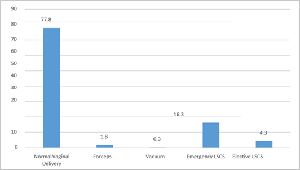Intersecting Journeys: Evaluating Primary Cesarean Sections among Multiparous Women in Tertiary Care
Authors
##plugins.themes.bootstrap3.article.main##
Abstract
Background: Cesarean section has become the most prevalent surgical procedure involving the delivery of a fetus through an incision in the uterus. Unnecessary labor induction can result in prolonged first-stage labor, increasing the risk of cesarean section, maternal fever, and postpartum hemorrhage. Objectives: Cesarean section rates have been increased thanks to safety in modern trends in anesthesia, blood transfusion facilities and higher antibiotics. The indications for Cesarean section are liberalized to include dystocia, placenta previa, fetal distress and bad obstetric history. Methods: An observational study of primary cesarean section performed in 400 multiparous women who had previous normal vaginal delivery in tertiary care hospital in Kerala. Results: In this study, 20.6% underwent LSCS including elective (4.3%) and emergency (16.3%). The most common indication was Fetal distress 24.3%, followed by cephalopelvic disproportion in 23.1%, malpresentation 12.1%, severe maternal PIH 6%. Percentage of Second stage arrest, maternal request, fetal Doppler changes and preterm labor was 4.8% each. Conclusion: A multipara who had previous vaginal deliveries should not be regarded as diagnostic-criteria for spontaneous delivery for the present pregnancy. Appropriate care is essential in intra and postpartum period to reduce both maternal and fetal mortality and morbidity.
##plugins.themes.bootstrap3.article.details##
Copyright (c) 2025 Aiswarya Siva, Asha G, Bindu I N

This work is licensed under a Creative Commons Attribution 4.0 International License.
Creative Commons License All articles published in Annals of Medicine and Medical Sciences are licensed under a Creative Commons Attribution 4.0 International License.
[1] Bajaj P, Kadikar G, Parmar DC, Bhatt M. A Study of Primary Cesarean Section in Multipara: A Study of Primary Cesarean Section in Multipara. Natl J Integr Res Med [Internet]. 2018 Feb. 1 [cited 2025 Jun. 14];8(2):161-3.
[2] Surekha S. Mohan, Chamaraja Thippeveeranna, Laiphrakpam R. Singh, Naorem N. Singh. Primary caesarean section in multiparous women: A clinical study from tertiary care centre in North East India. Indian Journal of Obstetrics and Gynecology Research. 2017;4(4):420-423.
[3] Dr. Leena Gattam, Dr. P.Hima Bindu. A study of Primary cesarean section in Multiparous women. IOSR Journal of Dental and Medical Sciences. March 2019 ;18(3): 14-26.
[4] Jessie Ford, Jagteshwar Grewal, Rafael Mikolajczyk, Susan Meikle, Jun Zhang. Primary Cesarean Delivery Among Parous Women in the United. Obstet Gynecol. 2008 December; 112(6): 1235-1241.
[5] Annelee Boyle, Uma M. Reddy, MPH, Helain J. Landy, Chun-Chih Huang, Rita W. Driggers, S. Katherine Laughon. Primary Cesarean Delivery in the United States. American College of Obstetricians and Gynecologists. Obstet Gynecol 2013;0:1-8.
[6] US Hangarga and Bhagyarekha Yattinamani. Clinical study of primary cesarean section in multiparous women. International Journal of Clinical Obstetrics and Gynaecology 2020; 4(2): 32-34.
[7] Blankenship SA, Raghuraman N, Delhi A, et al: Association of abnormal first stage of labor duration and maternal and neonatal morbidity. Am J Obstet Gynecol 223(3):445.e1, 2020.
[8] Villar J, Carroli G, Zavaleta N, et al: Maternal and neonatal individual risks and benefits associated with caesarean delivery: multicentre prospective study. BJM 335:1025, 2007.
[9] Cheesman K, Brady JE, Flood P, et al: Epidemiology of anesthesia-related complications in labor and delivery, New York State, 2002-2005. Anesth Analg 109:1174, 2009.
[10] Hawkins JL, Chang J, Palmer SK, et al: Anesthesia-related maternal mortality in the United States: 1979-2002. Obstet Gynecol 117(1):69, 2011.
[11] Linder N, Linder I, Fridman E, et al: Birth trauma—risk factors and short-term neonatal outcome. J Matern Fetal Neonatal Med 26(15):1491, 2013.
[12] Moczygemba CK, Paramsothy P, Meikle S, et al: Route of delivery and neonatal birth trauma. Am J Obstet Gynecol 202(4):361.e1, 2010.
[13] Alexander JM, Leveno KJ, Hauth J, et al: Fetal injury associated with cesarean delivery. Obstet Gynecol 108(4):885, 2006.
[14] Desai Erika, Leuva Harshraj, Leuva Bakul, Kanani Medha. A study of primary caesarean section in multipara. International Journal of Reproduction, Contraception, Obstetrics and Gynecology. 2013 Sep;2(3):320-324.
[15] Himabindu P, Tripura SM, Sireesha KV, Sairam MV. Primary Caesarian Section in Multipara. IOSR Journal of Dental and Medical Sciences.2015; 14(5):22-5.
[16] Ashok Naniwal, Paotadistrict Hospital, Pankaj Khandelwal, Khanjan Modesara. Study of primary caesarean section in multiparous women in district hospital. International Journal of Scientific Research 2019 December ;8(12); 11-12.

